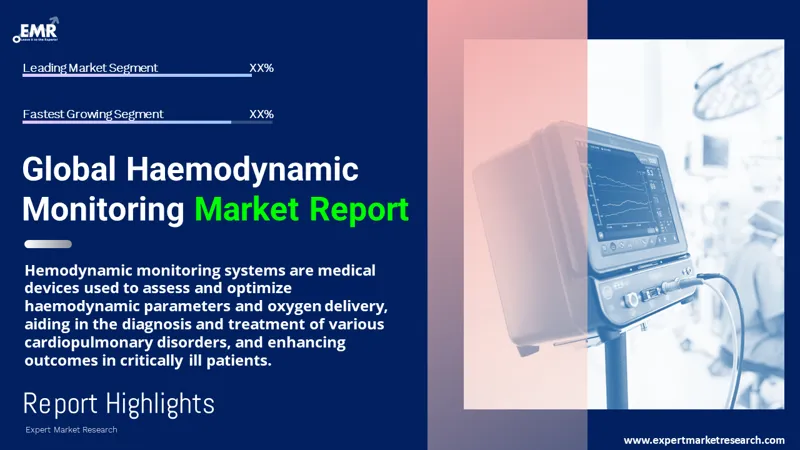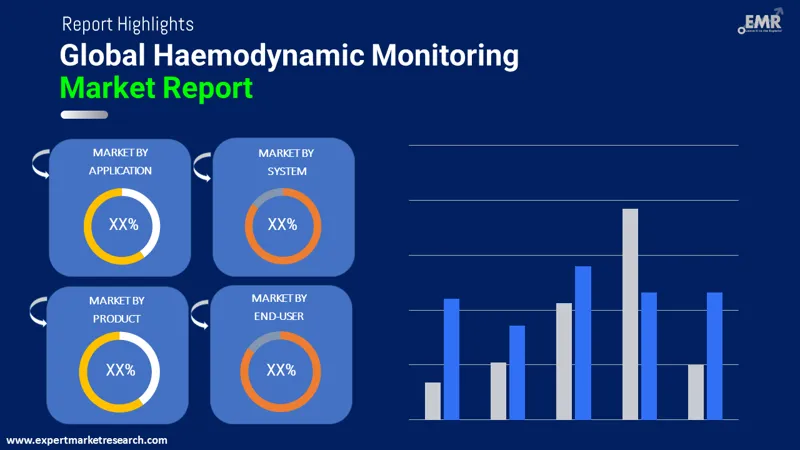
Consumer Insights
Uncover trends and behaviors shaping consumer choices today
Procurement Insights
Optimize your sourcing strategy with key market data
Industry Stats
Stay ahead with the latest trends and market analysis.
The global haemodynamic monitoring systems market was valued at USD 1.17 Billion in 2025 driven by the rising advancements in haemodynamic monitoring systems and the increasing burden of cardiovascular diseases. The market is further expected to grow at a CAGR of 5.20% in the forecast period of 2026-2035 to reach a value of over USD 1.94 Billion by 2035.
Base Year
Historical Period
Forecast Period
The rising burden of cardiovascular diseases and the growing geriatric population drive the market demand in the forecast period.
Minimally invasive monitoring systems hold a significant market share owing to the rising advancements in sensor technology and data analytics that have improved the accuracy and reliability of these devices.
In North America, the market is likely to grow over the forecast period because of rising regulatory approvals for monitoring devices and new product releases.
Compound Annual Growth Rate
5.2%
Value in USD Billion
2026-2035
*this image is indicative*
Hemodynamic monitoring systems are devices that allow for the evaluation and optimisation of haemodynamic parameters and oxygen delivery, which aids in the diagnosis and treatment of a variety of cardiopulmonary disorders and improving outcomes in critically ill patients. Haemodynamic monitoring has progressed over time from simple CO tracking to complex sensors that offer data on a variety of factors, such as blood pressure, blood volume, and fluid balance.

Read more about this report - REQUEST FREE SAMPLE COPY IN PDF
The haemodynamic monitoring systems market share is influenced by the increasing cases of critically ill geriatric patients, the rising prevalence of cardiac disorders, and the surging demand for home-based and non-invasive monitoring systems. The advancements in technology due to funding from private players and government bodies and the increasing prevalence of hypertension are also propelling the market demand. As haemodynamic monitoring systems are primarily used to assess the cardiovascular health, longevity, and quality of life of patients undergoing or recuperating from cardiac surgery, the parameters are measured using photo metrics, electrical, pressure transducing equipment and invasive and non-invasive devices. Thus, the rising burden of cardiovascular diseases is poised to impact the market dynamics.
The haemodynamic monitoring systems market value is also being driven by factors, such as technological advancements, increasing research and development (R&D) activities, an influx of venture capital funding, the rising incidences of surgeries, industry-wide awareness initiatives, and the growing government focus on critical care infrastructure and services. Also, the increasing demand for patient monitoring devices in non-hospital settings and emerging economies is likely to provide lucrative growth possibilities for market competitors.
Increasing Prevalence of Cardiovascular Diseases Impacts Market Landscape
Recent data reveals that cardiovascular disease is the leading cause of mortality for men and women worldwide. Around 620 million people in the world are affected by heart and circulatory disease, which translates to roughly 1 in 13 people living with a heart or circulatory condition . The rising burden of cardiovascular diseases is a significant growth driver of the market as these devices help in continuous haemodynamic monitoring, early diagnosis, and effective management of the cardiovascular condition necessary to prevent complications.
Technological Advancements Set to Fuel Haemodynamic Monitoring Systems Market Demand
In October 2023 , Chinese medical device company Mindray Bio-Medical Electronics Co., Ltd’s BeneVision N-Series became the first patient monitoring system to integrate the FloTrac sensor (developed by United States-based Edwards Lifesciences) for hemodynamic monitoring, expanding the N-Series capability to monitor patients' hemodynamic condition. This advancement offers a vital tool to healthcare providers for proactively addressing potential declines in a patient's condition and personalizing fluid management strategies. The introduction of such innovative haemodynamic monitoring solutions is expected to bolster the market growth in the forecast period.
The market is witnessing several trends and developments to improve the current global scenario. Some of the notable trends are as follows:

Read more about this report - REQUEST FREE SAMPLE COPY IN PDF
The EMR’s report titled “Haemodynamic Monitoring Systems Market Report and Forecast 2026-2035" offers a detailed analysis of the market based on the following segments:
Market Breakup by System
Market Breakup by Application
Market Breakup by Product
Market Breakup by End User
Market Breakup by Region
Market Segmentation Based on System is Anticipated to Witness Substantial Growth
By system, the market is segmented into minimally invasive monitoring systems, invasive monitoring systems, and non-invasive monitoring systems. Minimally invasive monitoring systems hold a significant market share owing to the rising advancements in sensor technology and data analytics that have improved the accuracy and reliability of these devices. These systems are suitable for a broader patient population as they offer less discomfort and shorter recovery times. Moreover, non-invasive monitoring systems are also poised to witness considerable growth driven by increasing demand for patient-friendly monitoring methods, innovations in non-invasive technology, and the rising preference for outpatient and homecare settings.
North America holds a significant share of the market, owing to rapid technological advancements in the region. The rising development of technologically equipped hospitals and the increasing number of critically sick patients treated in countries like the United States and Canada are driving the market demand. As the prevalence of diseases, such as cancer, hyperthermia, and other cardiovascular issues is surging, the use of haemodynamic monitoring systems is significantly increasing, which is fuelling the market growth.
The haemodynamic monitoring systems market is likely to grow over the forecast period because of rising regulatory approvals for monitoring devices and new product releases in the region. The growth can also be attributed to the high prevalence of cardiovascular diseases and diabetes and the increasing product launches. The intensifying competition in the region is leading to the development of innovative haemodynamic monitoring systems, which are further projected to boost the market share. Additionally, the Asia Pacific region is expected to witness robust growth owing to the rising governmental focus on quality healthcare, high demand for monitoring devices from India, China and Japan, and high diabetes prevalence.
The key features of the market report comprise patent analysis, and strategic initiatives such as joint ventures along with partnerships and collaborations by the key players. The major companies in the market are as follows:
This global provider of medical technology solutions has a prominent presence in the market. Its advanced hemodynamic patient monitoring platform, PulsioFlex , features modular expandability and efficient monitoring technologies.
Headquartered in California, Edwards Lifesciences is an American medical technology company specialising in haemodynamic monitoring. It boasts a robust portfolio of advanced hemodynamic monitoring solutions comprising a range of sensors, software, cuffs, and catheters.
Technology company Koninklijke Philips N.V. is one of the leading market players and significantly contributes to the haemodynamic monitoring systems market growth. One of its key products is the IntelliVue monitoring system which includes advanced haemodynamic monitoring features integrated into comprehensive patient monitoring solutions.
ICU Medical is a medical device company that is known for its innovative Cogent 2-in-1 hemodynamic monitoring system. Cogent 2-in-1 Hemodynamic Monitoring System is designed to accept both minimally invasive and invasive inputs, allowing healthcare providers to use a single monitor regardless of changes in patient conditions and monitoring requirements.
*Please note that this is only a partial list; the complete list of key players is available in the full report. Additionally, the list of key players can be customized to better suit your needs.*
Other key players in the market include LiDCO Limited, Schwarzer Cardiotek GmbH, OSYPKA MEDICAL, Nihon Kohden Corporation, Deltex Medical Limited, and TELEFLEX INC.




*While we strive to always give you current and accurate information, the numbers depicted on the website are indicative and may differ from the actual numbers in the main report. At Expert Market Research, we aim to bring you the latest insights and trends in the market. Using our analyses and forecasts, stakeholders can understand the market dynamics, navigate challenges, and capitalize on opportunities to make data-driven strategic decisions.*
Get in touch with us for a customized solution tailored to your unique requirements and save upto 35%!
Explore our key highlights of the report and gain a concise overview of key findings, trends, and actionable insights that will empower your strategic decisions.
| REPORT FEATURES | DETAILS |
| Base Year | 2025 |
| Historical Period | 2019-2025 |
| Forecast Period | 2026-2035 |
| Scope of the Report |
Historical and Forecast Trends, Industry Drivers and Constraints, Historical and Forecast Market Analysis by Segment:
|
| Breakup by System |
|
| Breakup by Application |
|
| Breakup by Product |
|
| Breakup by End User |
|
| Breakup by Region |
|
| Market Dynamics |
|
| Supplier Landscape |
|
| Companies Covered |
|
Datasheet
One User
USD 3,299
USD 2,969
tax inclusive*
Single User License
One User
USD 5,499
USD 4,949
tax inclusive*
Five User License
Five User
USD 6,999
USD 5,949
tax inclusive*
Corporate License
Unlimited Users
USD 8,199
USD 6,969
tax inclusive*
*Please note that the prices mentioned below are starting prices for each bundle type. Kindly contact our team for further details.*
Flash Bundle
Small Business Bundle
Growth Bundle
Enterprise Bundle
*Please note that the prices mentioned below are starting prices for each bundle type. Kindly contact our team for further details.*
Flash Bundle
Number of Reports: 3
20%
tax inclusive*
Small Business Bundle
Number of Reports: 5
25%
tax inclusive*
Growth Bundle
Number of Reports: 8
30%
tax inclusive*
Enterprise Bundle
Number of Reports: 10
35%
tax inclusive*
How To Order

Select License Type
Choose the right license for your needs and access rights.

Click on ‘Buy Now’
Add the report to your cart with one click and proceed to register.

Select Mode of Payment
Choose a payment option for a secure checkout. You will be redirected accordingly.
Gain insights to stay ahead and seize opportunities.

Get insights & trends for a competitive edge.

Track prices with detailed trend reports.

Analyse trade data for supply chain insights.

Leverage cost reports for smart savings

Enhance supply chain with partnerships.

Connect For More Information
Our expert team of analysts will offer full support and resolve any queries regarding the report, before and after the purchase.
Our expert team of analysts will offer full support and resolve any queries regarding the report, before and after the purchase.
We employ meticulous research methods, blending advanced analytics and expert insights to deliver accurate, actionable industry intelligence, staying ahead of competitors.
Our skilled analysts offer unparalleled competitive advantage with detailed insights on current and emerging markets, ensuring your strategic edge.
We offer an in-depth yet simplified presentation of industry insights and analysis to meet your specific requirements effectively.
Share